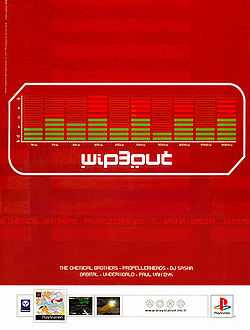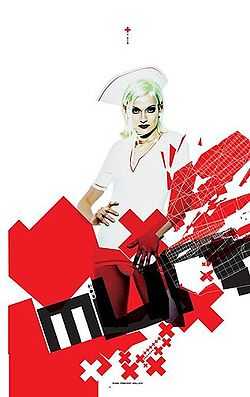The Designers Republic

The Designers Republic (tDR for short) is a graphic design studio and based in Sheffield, England, founded by graphic designer Ian Anderson in February 1986. It was known for its anti-establishment aesthetics, while simultaneously embracing brash consumerism and the uniform style of corporate brands, such as Orange and Coca-Cola. The studio in its larger form closed in January 2009, with Anderson stating that it would continue in a more 'slimline' form. [1] [2]
History
Initially, Ian Anderson founded The Designers Republic to design flyers for the band Person to Person, which he managed at the time. His first ideas were inspired by Russian constructivism.
An early client was Leeds band Age of Chance, for whom they developed a series of record covers between 1986 and 1987. The sleeve of the 1987 12-inch "Don't Get Mad... Get Even! (The New York Remixes)" was selected as one of Q’s "100 Best Record Covers of All Time" in 2001.[3]
In 1994, Emigre magazine devoted a whole issue to the Designers Republic, a copy of which was bought by NY MoMA. This issue is still Emigre’s best-ever seller and is now sold out[4]
The Designers Republic was introduced to a larger audience by their record covers for the English electronica label Warp Records (also based in Sheffield). In addition to designing the covers for much of Warp's roster of artists, such as Autechre and Aphex Twin, tDR has also created covers for other label artists such as Moloko, Fluke, Funkstörung, The Orb, Pulp (and Jarvis Cocker), Pop Will Eat Itself, Supergrass and Towa Tei.
Outside the musical sector, tDR created the visuals, packaging and manual for the PlayStation–Sega Saturn game Wipeout (1995), the interface for the PC game Hardwar (1998), and packaging and posters for the first Grand Theft Auto (1997). They cooperated with the Swatch company in 1996 to design their own watch. They also designed the packaging for Sony's AIBO.
The book 3D → 2D: Adventures in And Out Of Architecture, released in 2001, was an architectural examination of the Chamber of Commerce and Industry of Slovenia presented in the graphic style of their previous work.
tDR has consulted on the re-branding of the city of Quito, capital of Ecuador, and was the only non-national design company to be invited to propose a new flag for Slovenia.[5] tDR was also commissioned to create a logo and general graphic design by French musician-producer Julien Civange for its Music2Titan mission to take music on the European Space Agency's Cassini–Huygens probe to the moon Titan in 2004.[6]
On 20 January 2009, after 23 years in operation, tDR went into voluntary liquidation, Anderson bought back the company name and assets, and relaunched tDR as a smaller outfit.[1][2]
Style
The Designers Republic's works are often playful and bright, and considered Maximum-minimalist, mixing images from Japanese anime and subvertised corporate logos, with a postmodern tendency towards controversial irony, featuring statements like "Work Buy Consume Die", "Robots Build Robots", "Customized Terror", "Buy nothing, pay now", and "Made in the Designers Republic". They also celebrated their northern roots with phrases like "Made in the Designers Republic, North of Nowhere" and "SoYo" (referring to Sheffield's county of South Yorkshire) — affirming they were not from London's design community in Soho.

Works
TDR have worked in a diverse range of media, including:
- Covers of CDs, vinyl records and DVDs
- Typography
- Web design
- Music video production
- Apparel design
- Packaging
- Corporate design
- Logo design
Notable clients
- The Orb [4]
- Pop Will Eat Itself [4]
- Age of Chance [4]
- Adidas
- Aphex Twin
- Autechre
- Coca-Cola
- Gatecrasher
- Cartoon Network
- Detroit Underground
- Electraglide
- Hasbro
- JVC
- Lynx
- MPC
- MTV
- Nickelodeon
- Nokia
- Orange
- Polygram
- Pringles
- Psygnosis
- Reebok
- Rockstar Games
- Pringles
- Sony
- Swatch
- VH-1
- Warp Records
Past Members
- Michael C. Place - Now runs Build
- David Bailey - Now runs Kiosk
- Matt Pyke - Now runs Universal Everything
- Nick Bax - Now runs Human Studio
- Martin Fewell - Now runs Yolo
- Nicole Jacek - Now runs NJ (L.A.)
References
- ↑ 1.0 1.1 Farrelly, Liz (Spring 2009). "Reputations: Ian Anderson". Eye Magazine Blog. Retrieved 21 August 2014.
- ↑ 2.0 2.1 Burgoyne, Patrick (23 January 2009). "The Designers Republic Is Dead; Long Live The Designers Republic". Creative Review Blog. Retrieved 24 January 2009.
- ↑ Harrison, Ian (2001). "Age of Chance: Don't Get Mad Get Even! (The New York Remixes)". Q: The 100 Best Record Covers of All Time. EMAP. p. 72. Retrieved 24 January 2009.
- ↑ 4.0 4.1 4.2 4.3 "Back Issues: Emigre 29". Emigre. Retrieved 24 January 2009.
- ↑ Brain Aided Design SoYo: The Designers Republic
- ↑ http://www.music2titan.com/